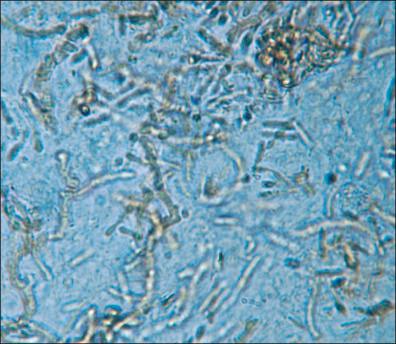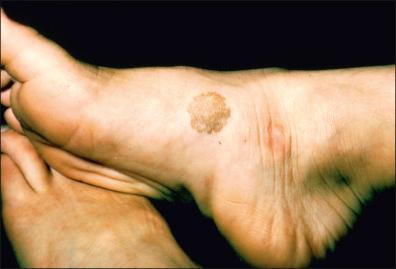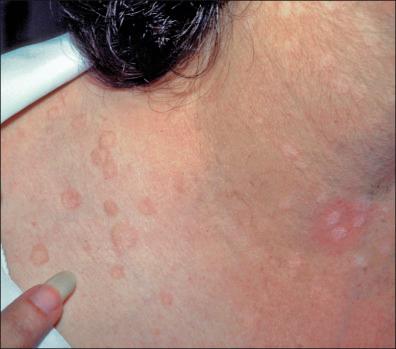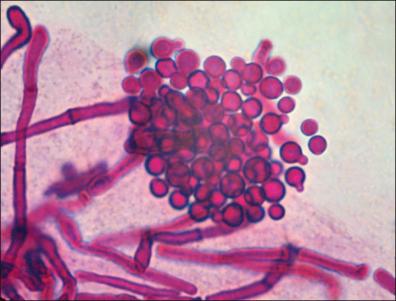Physical Address
304 North Cardinal St.
Dorchester Center, MA 02124
Fungal disease involving human keratinized tissue may be caused by dermatophytes, non-dermatophytic fungi, or a combination of both. Superficial disease caused by non-dermatophytes is limited to the stratum corneum, hair, or both. When fungi grow on the host, there is little to no host immune response. Cutaneous disease involves the epidermis and dermis and there is an inflammatory reaction similar to contact dermatitis. Because the stratum corneum, hair, and nail are non-viable, disease caused by these fungi is simply colonization of the host and not an infection. Infection occurs when a fungus grows and replicates in sterile viable tissue or body fluids.
The dermatophytes are a phylogenetically related group of filamentous ascomycetes classified in the genera Epidermophyton , Microsporum , and Trichophyton . These molds have keratinases which allow them to grow in keratinized tissues on the host. Fungi that are able to use the protein keratin for growth are referred to as keratinophilic fungi. Not all keratinophilic fungi are dermatophytes, whereas all dermatophytes are keratinophilic. The distinction between the two groups relates to the fact that dermatophytes grow on the living host, whereas the other fungi do not.
Historically, mycoses involving skin, nail, and hair have been classified based upon their clinical presentation and body site of involvement ( Table 17-1 ). Clinically descriptive terms such as black piedra and tinea nigra have been used for some of these diseases when dematiaceous fungi are the etiologic agents, and the term tinea versicolor has been used for the lipophilic yeast genus Malassezia . To maintain the integrity of the clinical term tinea for dermatophyte, tinea should be restricted to dermatophyte-caused disease, and other well-established terms like pheohyphomycosis, hyalohyphomycosis, and pityriasis versicolor should be used for diseases caused by non-dermatophytes. Hyalohyphomycosis is a companion term to pheohyphomycosis and includes non-dematiaceous fungi, whereas pityriasis versicolor is caused by yeast, even though hyphae may be present in the lesions.
| Disease | Body Area | Primary Clinical Symptoms |
|---|---|---|
| Pityriasis versicolor | Trunk, arms | Branny discoloration or depigmentation |
| Pheohyphomycosis | ||
| Black piedra | Hair | Carbonaceous black nodules |
| Superficial | Palms, dorsum of foot | Non-scaly, sharply marginated, brown-black macules |
| Tinea barbae | Beard | Scaling, red patches on face and neck |
| Tinea capitis | Scalp | Scaling, fissures, erythema, burning |
| Tinea corporis | Body | Scaling, alopecia, inflammation, secondary bacterial infection |
| Tinea cruris | Groin | Erythema, papules, well-demarcated lesions |
| Tinea pedis | Foot | Erythema, scaling, maceration, interdigital spaces |
| Tinea unguium and onychomycosis | Nail | Opaque, yellow, thickened nail |
Black nodules adhering to hair shaft.
Ascospores in potassium hydroxide mount.
Culture not necessary.
Management with haircut.
Etiologic agent is Piedraia hortae.
Black piedra is a disease of hair in which the ascomycete Piedraia hortae forms ascostromata containing asci and ascospores. The disease is primarily found on people living in Africa, Asia, and Central America. Hair involvement is least among children, and both sexes are equally involved.
As the fungus grows on the hair, it destroys the cuticular layers of the hair. The fungus then penetrates deeply into the cortex. Around the hair, the ascomycetous fruiting body contains locules that have asci and ascospores are formed. These structures are black, hard, and remain attached to the hair when the hair is pulled between two fingers. Management consists of a haircut. The use of antifungal agents is not necessary, nor is there a need to culture the fungus in the laboratory. The diagnosis is made by the clinical presentation and direct examination of the black nodules in 10–15% potassium hydroxide.
Tinea nigra, tinea nigra palmaris, keratomycosis nigricans, cladosporiosis epidemica, pityriasis nigra, microsporosis nigra
Asymptomatic development of a light-brown macule, usually on the palmar surface of the hand and fingers (synonym: tinea nigra palmaris). Lesions may be observed on the plantar surface of the foot (synonym: tinea nigra plantaris), neck, and thorax. The light-brown macules spread centrifugally and darken to brown-black owing to the presence of the dematiaceous fungus.
Color is mottled, with deeper pigmentation seen on the periphery of the involved tissue.
The etiologic agent is Hortaea werneckii (synonym: Cladosporium werneckii , Exophiala werneckii , Phaeoannellomyces werneckii ).
The condition is endemic in tropical and subtropical coastal regions of the Caribbean, Asia, Africa, South and Central America. Cases have been reported in southeastern USA coastal regions and Europe. The etiologic agent possesses a high tolerance for salt.
The disease is painless and characterized by single, sharply demarcated non-scaly macules found on the palm of the hand and fingers. Lesions may also occur on the sole of the foot and other skin surfaces such as the neck and thorax. The lesion gradually enlarges, with the darkest pigmentation being at the periphery. The disease typically does not elicit an inflammatory response. This disease has been often misdiagnosed as other hyperpigmentation processes such as malignant melanomas.
The first authentic description of the disease was made by Alexandra Cerqueira (1891) in Bahai, Brazil. He gave it the clinical name keratomycosis nigricans palmaris. It was not until 1916 that Alexandra Cerqueira's son, Castro Cerqueira-Pinto, published findings for eight other cases. For the disease seen in Asia, Castellani described the etiologic agent Cladosporium mansoni . It was not until 1921 that Horta described the etiologic agent as C. werneckii . McGinnis and Schell showed that C. werneckii and C. mansoni were the same species and then renamed the fungus Phaeoannellomyces werneckii . Nishimura and Miyaji subsequently renamed the same fungus as Hortaea werneckii . Owing to the fact that Nishimura and Miyaji named the fungus first, H. werneckii is the correct name.
With increased travel by many individuals, the disease has been found in tropical and non-tropical areas. For example, 15 cases of tinea nigra were described in North Carolina. With increased awareness of the disease, more cases have since been reported in the USA and Europe. People living in coastal regions of the Caribbean, Asia, Africa, South and Central America, and the southeastern USA coastal regions and Europe, most frequently develop superficial pheohyphomycosis caused by Hortaea . This may be related to the high tolerance the fungus has for salt. Children and young adults are more often affected, as well as non-immunocompromised individuals. In most studies, females are affected more frequently than males. There appears to be no genetic predisposition to this disease.
The fungus is confined to the stratum corneum and does not normally elicit an inflammatory response. A second fungus, known as Stenella araguata , has been described as a rare etiologic agent of this disease. A slightly abnormal thickening of the stratum corneum may be observed because of the large amount of fungal elements that can be present. Branched, brown hyphae ( Fig. 17-1 ) appear in the stratum corneum; the stratum lucidum is spared. Biopsies show small areas of abnormality in the horny layer of the skin, which result in disturbance of keratinization. A small amount of perivascular infiltrate can also be seen.

The disease is asymptomatic in most cases, but may be associated with pruritus. It is characterized by the formation of a single, sharply demarcated non-scaly macule that may resemble a silver nitrate stain ( Fig. 17-2 ). Lesions enlarge (1 mm to 1.5 cm) gradually and the darkest pigmentation can be seen at the periphery. The dark color of the lesion is due to the melanin in the cell walls of the etiologic agent.

Diagnosis of the infection can be done by a simple epidermal scraping from the lesion. Examination of skin scrapings reveals brown to olive, septate, branching hyphae measuring 1.5–5 µm in diameter. Elongate, two-celled, budding yeast cells, 3 × 10 µm, are also typically seen in skin scrapings. The budding cells may be in clusters or along the length of dark hyphae. Older growth may appear twisted, with numerous septa and thickening of the cell walls, which become deeply pigmented. H. werneckii is a black yeast because of the presence of melanin in its yeast cell walls, which contributes to the pheoid color of its yeast-like colonies.
Skin scrapings can be inoculated onto potato dextrose agar, mold-inhibitory agar, or Sabouraud dextrose agar. After 5–7 days of incubation at 30°C, slow-growing mucoid colonies develop that become olive to greenish-black in color. As the colonies mature, aerial mycelium develops.
Macules showing an uneven rate of spread, coalescence, or both raise the suspicion of melanomas, melanocytic nevi, or junctional nevi. Other differential diagnoses include pigmentation of Addison's disease, melanosis from syphilis, postinflammatory melanosis, palmoplantar pigmentation, and stains from chemicals or dyes.
Spontaneous resolution of the condition is rare. Whitfield's ointment, salicylic acid preparations, and tincture of iodine and other keratolytic agents have been successful to various degrees. The topical use of 10% tiabendazole, an antiparasitic drug, or azoles such as miconazole, clotrimazole, ketoconazole, and itraconazole have been used. Oral griseofulvin is ineffective in the treatment of this disease.
Tinea versicolor, tinea alba, dermatomycosis furfuracea, tinea flava, achromia parasitica, malasseziasis, liver spots
Pityriasis versicolor is a chronic, asymptomatic to mild disease of the stratum corneum.
Lesions are bran-like to furfuraceous in consistency. They are discrete or joined together, discolored or depigmented areas of skin. The lesions appear mainly on the upper trunk, neck, and upper arms.
The etiologic agent is the lipophilic yeast Malassezia furfur , formerly known as Pityrosporium orbiculare or P. ovale . M . symptodialis is also associated with humans. M. pachydermatis is less frequently seen in humans but is common in certain animals. Six different species of Malassezia have been described.
It is a common condition in temperate climates and is very prevalent in the tropics and subtropics, sometimes occurring in up to 60% of the population. It has been reported in Mexico, Samoa, South and Central America, India, parts of Africa, Cuba, regions of the Mediterranean, and the West Indies.
Pityriasis versicolor is a mild to chronic colonization of the stratum corneum by the lipophilic fungus Malassezia furfur . The clinical manifestation is characterized by scaly hypopigmented or hyperpigmented lesions that are usually on the trunk of the body ( Fig. 17-3 ).

M . furfur is a human and animal colonizer whereas M. pachydermatis is most commonly found in animals such as dogs. M. furfur is most commonly identified with human infections, followed by M. pachydermatis . The role of M. symptodialis as an etiologic agent of human disease has not been extensively studied. Some case reports suggest that this lipophilic yeast may be involved with human disease. It appears that M. furfur is universally present as part of the normal human flora of the skin.
A lesion may consist of one continuous scaling sheet at the affected area. In contrast, other lesions may present as patches of fawn, yellow-brown, or dark-brown-colored processes. Owing to the characteristics of the lesions, tinea corporis, secondary syphilis, pinta, melanoma, seborrheic keratoses, acanthosis nigricans, melasma, diabetic dermopathy, reticulated papillomatosis of Gougerot–Carteaud syndrome, and postinflammatory hyperpigmentation or hypopigmentation after trauma, skin irritation, or dermatoses must be considered in the differential diagnosis.
In 1846, Eickstedt, and later Sluyter in 1847, observed the fungal etiology of the disease and named it pityriasis versicolor. In 1853, Robin named the etiologic agent Microsporum furfur , because he thought that it was related to the dermatophyte Microsporum audouinii . He changed the disease epithet to tinea versicolor because he thought it was related to the other ringworm infections. Baillon changed the name in 1889 when he concluded that the two fungi were not related. He created the monotype genus Malassezia and named the fungus M . furfur . Morris Gordon first isolated the fungus in culture and named it Pityrosporium orbiculare , which is now considered a synonym of Malassezia . Based on molecular data, the genus Malassezia has been revised and several new species have been added.
Malassezia species are saprophytic yeasts that grow on normal skin of the trunk, head, and neck, where there tends to be large quantities of lipids. It is a disease that classically affects young people of either sex. Typically, the disease occurs in individuals prior to puberty. It is thought that the composition of sebum from the sebaceous glands influences the frequency of pityriasis versicolor in different age groups. This may be due to hormonal changes, malnutrition, oral contraceptives, and hyperhidrosis. Rarely, pityriasis versicolor may occur in immunocompromised individuals such as those with Cushing's syndrome. Transitory fungemia has been observed in infants who received intravenous lipid-containing formulations. This problem does not require antifungal agents, but the catheter must be replaced. Pityriasis versicolor occurs in patients living in all climates, but its prevalence in the tropics is very high, sometimes with 60% of the population showing clinical signs of the disease.
There are at least eight species in the genus Malassezia . The most common and well-characterized species causing pityriasis versicolor are M. furfur and M. pachydermatis . M. globosa and other species of Malassezia may be associated with this disease. Members of this genus are considered one of the factors that initiate seborrheic dermatitis.
The yeast is a basidiomycetous fungus that forms bottle-shaped cells having a small collarette. The yeast cells occur in clusters with the presence of septate hyphae that appear truncate ( Fig. 17-4 ). In stratum corneum, the fungus may occur only as yeast cells, yeast cells with hyphae, or only hyphae.

Topical and oral therapies are effective in treating this disease, even though relapse is common. Selenium sulfide, propylene glycol, sulfur with salicylic acid, and benzoyl peroxide – chemical agents that remove the stratum corneum and that are not active against the yeast – are effective therapeutic modalities. Clotrimazole, miconazole, ketoconazole, and fluconazole, the latter two replacing the other azoles, are effective in 2% creams and shampoos, or as foaming gels.
Terbinafine as a 1% solution, a cream, a gel, and a spray is effective. Ketoconazole, itraconazole, and fluconazole have been shown to be effective when taken orally by patients with large or multiple lesions.
Ringworm of the scalp, eyebrows, and eyelashes, tinea tonsurans
Inflammation and pain, red scaling areas, alopecia, brittle hair leading to hair loss and formation of black dots, boggy ulcerated skin lesions.
Broad range of clinical presentation.
Griseofulvin, itraconazole, terbinafine, ketoconazole, and fluconazole are effective treatments.
Oral therapy is necessary to penetrate the hair shaft and clear scalp disease.
Become a Clinical Tree membership for Full access and enjoy Unlimited articles
If you are a member. Log in here